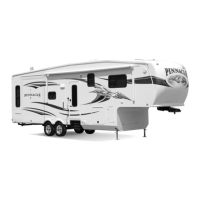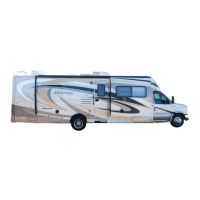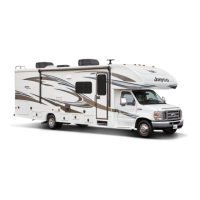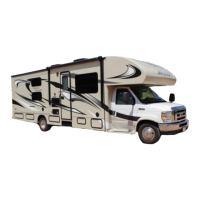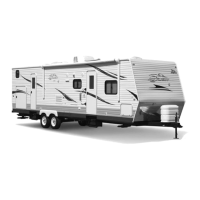SECTION 2
OCCUPANT SAFETY
Rating Intended use
Type A
For use on fires involving combustible
materials such as wood, cloth and
paper.
Type B
For use on flammable liquid fires,
including kitchen grease. Never use
water on this type of fire!
Type C
For use in fires involving energized
electrical equipment.
Type ABC
Works on all three types of fires listed
above.
Operation
Teach family members how to use the fire
extinguisher and replace it as recommended.
A portable fire extinguisher can save lives and
property by putting out a small fire or
containing it until the fire department arrives;
but portable extinguishers have limitations.
• It is important to recognize when to leave
the RV. Because fire grows and spreads
so rapidly, the number one priority is to
get out safely.
• Keep your back to a clear exit when you
use the fire extinguisher so you can make
an easy escape if the fire cannot be
controlled.
There are four different types and sizes of fire
extinguishers, but for the most part they all
work the same way. To operate a fire
extinguisher, remember the word PASS.
Pull the pin. Hold the extinguisher with the
nozzle pointing away from you, and release
the locking mechanism.
Aim low. Point the extinguisher at the base of
the fire.
Squeeze the lever slowly and evenly.
Sweep the nozzle from side-to-side until the
fire is out.
Disposal
Contact your local fire department, sanitation
department or environmental protection
department to find out what your local laws
stipulate before disposing of your used (non-
refillable) factory-installed dry chemical fire
extinguisher.
SMOKE ALARM
Three of the most common fire safety issues
are smoking in bed, leaving children
unattended and cleaning with flammable
fluids. The smoke alarm is intended to help
reduce those risks. Proper use and care of
your smoke alarm may save your life.
• Smoke alarms can only work if they are
properly located, installed, operational and
maintained and if smoke reaches them.
They are not foolproof.
• The factory-installed ceiling mounted
smoke alarm is operational once the 9-volt
battery is correctly connected. The LED
will flash to show the battery is supplying
power to the alarm.
Avoid inhaling the dry chemical agent in
the fire extinguisher. It is not toxic, but may
cause skin irritation. In case of contact,
flush the affected area with clean, cool
water. If irritation persists, contact a
physician immediately.
• The smoke alarm will not function if the
battery is missing, disconnected, dead,
the wrong type of battery is used or the
battery is installed incorrectly.
• When the product of combustion is
sensed, the smoke alarm sounds a loud
alarm that continues until the air is
cleared. If the smoke alarm sounds,
execute your family safety plan
immediately.
How to test
Stand at arm's length from the smoke alarm
when testing. The alarm horn is loud and may
be harmful to your hearing. The test button
will accurately test all functions. Never use an
open flame from a match or lighter to test the
smoke alarm; you may ignite and set fire to
the smoke alarm and your RV. If the smoke
alarm does not test properly, replace it
immediately.
17
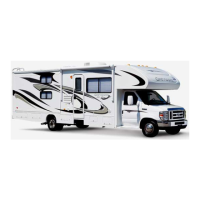
